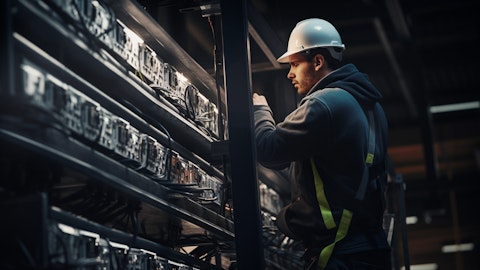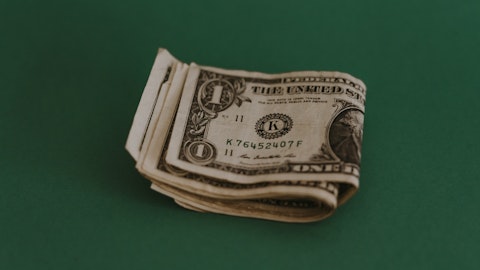Deane Dray: Good. And just to clarify on that import question, is it the same that it’s been for the past couple of years? Is it gotten bigger?
Bill Waltz: I think it varies. Like this year maybe slightly up, but then 2023 was down compared or fiscal year ’23 compared to ’22. So it almost varies then, Dean, to go, you’re talking in the last three months, you’re talking year-over-year. So the trend, Dean, I think in the last five years, to be totally honest, because Atkore is making more profits. It allows somebody that does not have any better cost position, to my knowledge, I’m not working on their books, but it does allow with us raising and our competitors raising market price for somebody to opportunistically come in. So there has been a trend there, but it’s not, again, it’s more on the things we discussed here. Let’s get Hobart running smoothly. Let’s get the beads act moving. Let’s continue to act on our global mega projects, our delivery, our productivity. Let’s use our excess cash to continue buying back shares. And I’m comfortable with where we’re taking the corporation.
Operator: Your next question is from the line of Chris Dankert from Loop Capital Markets. Please go ahead.
Chris Dankert: Good morning. Thanks for taking the questions. I guess to focus in on the HDPE. I guess, just to be clear, as far as the guide goes, are we assuming a stabilization at current order rates and activity levels, or does the guide assume some incremental fall off in the back half of the fiscal year? Or maybe just to level set what is baked into the guide and then just what’s giving you confidence from an order rate or customer activity perspective on an HDPE hitting that expectation?
David Johnson: Yes, Chris. So I would say that the back half of the year would be slightly better than the first half of the year would be what’s in the guide. And I say that’s supported by some uptick in current order rates.
Bill Waltz: But not sizable. This is not.
David Johnson: It’s modest.
Chris Dankert: Got you. Okay, that’s helpful. I’m glad to hear that. And then again, I know you mentioned in the past destocking is pretty well behind us. Is that still the view? Are we still seeing incremental destocking? Was there anything to call out in the quarter or kind of looking forward here?
Bill Waltz: No, I think. Great question, Chris. The only thing I would say is year-to-date, HDPE had destocked. That was a new thing, again, that no one expected a year ago. But otherwise, we do well, we’re always out with customers, but channel checks and a lot of people because of the lighter economy or even cutting inventories more, we were on with the customer last week that was talking about, well, how they may take down two days, but basically, it’s level loaded, I think, across the market.
Chris Dankert: Got it. Well, I’ll leave it there. And thank you so much for the detail.
Operator: Your next question is from the line of Alex Rygiel from B. Riley. Please go ahead.
Alex Rygiel: Thank you. And good morning, gentlemen. A couple quick questions here. When you look at your sales bridge, when might we anticipate price to be more neutral on a year-over-year basis?
David Johnson: I would say probably more so. A couple of things I’ll answer if you look at our guide, even for this year on an EBITDA basis, the implied midpoint of Q4 would be fairly flat with Q4 of last year. So that would be more or less the quarter where EBITDA would be flat. Now. You’re still going to have some pricing year-over-year down and some volume up, I would say pricing now again, sales in total, including what happens with commodities, because, that also does impact our top line is probably more of a Q1, Q2 next year.
Alex Rygiel: That is helpful. And then as it relates to large project opportunities, can you talk about how you see that sort of sequentially progressing over the next couple of quarters and maybe not so much identify specific projects, but identify specific sort of end markets that you see as being the biggest catalyst? Clearly, there’s a lot of talk about AI data centers, but if you could expand upon that.
Bill Waltz: Yes, I think, great question, Alex. It will expand into mostly an FY ’25 and beyond story. So again, the orders are coming in now. We do have orders now and we’re shipping orders now. So this isn’t a totally new thing. But, we’re dramatically increasing our team. We’re doing things called off site manufacturing. So partnering with some of the very largest names you can imagine, like in the magnificent seven right now where we’re doing their assembly offline and then, providing them the products. And as you mentioned, I think if I had to pick two areas, it’s both chip manufacturers and then it’s also data centers themselves and it’s across the world, mostly US story. But we do have operations where customers have taken us and said, hey, you did such a great job in this specific city and said, would you work with us in different areas in Europe, for example?
Alex Rygiel: Very helpful. Thank you.
Operator: Thank you. This concludes the question-and-answer session. I would now like to turn the call back over to Bill Waltz for closing remarks.
Bill Waltz: Thank you. Let me take a moment to summarize my three key takeaways from today’s discussion. First, volume is up 6% year-to-date, and we expect mid to high single digit volume growth for FY 2024. Second, we continue to execute our balanced capital deployment model with over $150 million in share repurchase year-to-date. Third, with a great team, market leading product portfolio and strategy supported by strong secular tailwinds, we are excited about what the future holds for Atkore. With that, thank you as always, for your support and interest in our company. We look forward to speaking with you during our next quarterly call. This concludes the call for today.
Operator: This concludes today’s conference call. Thank you for joining us, you may now disconnect.
Follow Atkore Inc. (NYSE:ATKR)
Follow Atkore Inc. (NYSE:ATKR)
Receive real-time insider trading and news alerts



